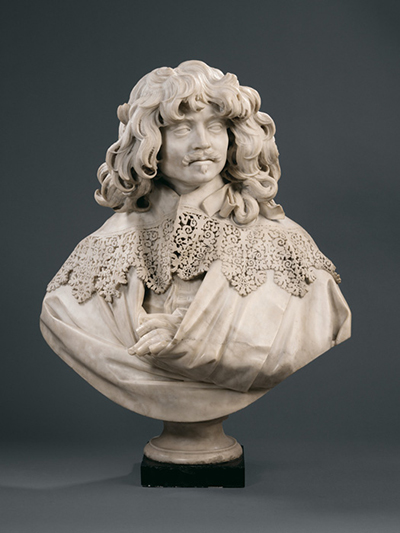Gian Lorenzo Bernini created the Bust of Tom Baker during the Baroque phase in the history of art. In sculpture, painting and architecture, Baroque is typified by fluid outlines and flowing curves.
In the years following the high Renaissance, which paralleled the religious Reformation, the Counter Reformation emerged. This intensely Catholic movement demanded an alternative artistic sensibility to the rigid angles and symmetry of the high Renaissance.
Patrons of Baroque work understood that feeling and emotion were as essential to religious sensibility, as reason and knowledge of the Bible. The fluid lines of Baroque art expressed this sensibility, and it slowly replaced the rigid lines and acute angles of high Renaissance art. Bernini did not actually sculpt the Bust of Tom Baker, which was completed by a workshop assistant from a live drawing by him. However, the bust is essentially a work by Bernini because of the virtuoso way that the marble is worked. To appreciate this virtuosity, consider his sculpture The Ecstasy of Saint Teresa (1645-1652), among the most famous of all of his works.
The Saint is lying upon a bank of undulating cloud, her clothing in disarray about her, while her mouth is falling open with religious ecstasy. A marble cupid is directing an arrow at her heart while rays of heavenly light descend upon the two figures. The contrast between the angular arrow and the rays of light, and the softness of the flesh and fabrics, heighten the drama in the painting. What is most astonishing of all is the way that the artist renders rigid marble as if it was a fluid material. Bernini had undoubtedly made studies of ancient Greek statues of clothed figures. However, although the classical sculptors made fine anatomies carved with lineaments that might resemble folds of clothing, Bernini was the first artist to actually render soft textures – like billowing cloud - in the material.
Throughout Bernini's lifetime, his marble sculptures astonished patrons to such an extent, that Pope Urban VIII commissioned him to redesign St Peter’s Basilica in the Vatican City, which is at the heart of Rome and the Catholic world. Paradoxically, this ability to render the heavenly and the supernatural in stone is the same skill that Bernini used to depict the natural world. With this skill, Bernini created portraits in marble, and achieved a realism in sculpture that hitherto only painters had achieved. Tom Baker was one of a number of wealthy men who desired one of these sculpted portraits.
The flowing strands of his hair cast shadows on the face in a most naturalistic fashion; in fact, every strand seems to have been carved individually, both growing from the head and the face. Meanwhile, the jovial expression communicates in a way to make the onlooker feel as if he knows Baker's character. So soft and tactile do the lace collar and clothing appear, that it is almost a shock when the "body" vanishes just below the cloth, which undulates with the weight of a notional arm and an emerging hand. But it was in the nature of Gian Lorenzo Bernini, Baroque artist and architect, sculptor and showman, to leave the onlooker in shock and awe.




